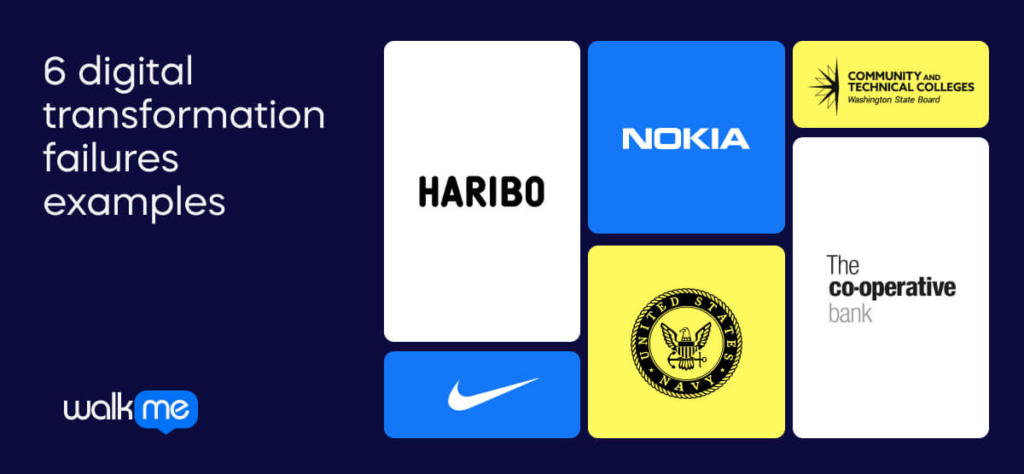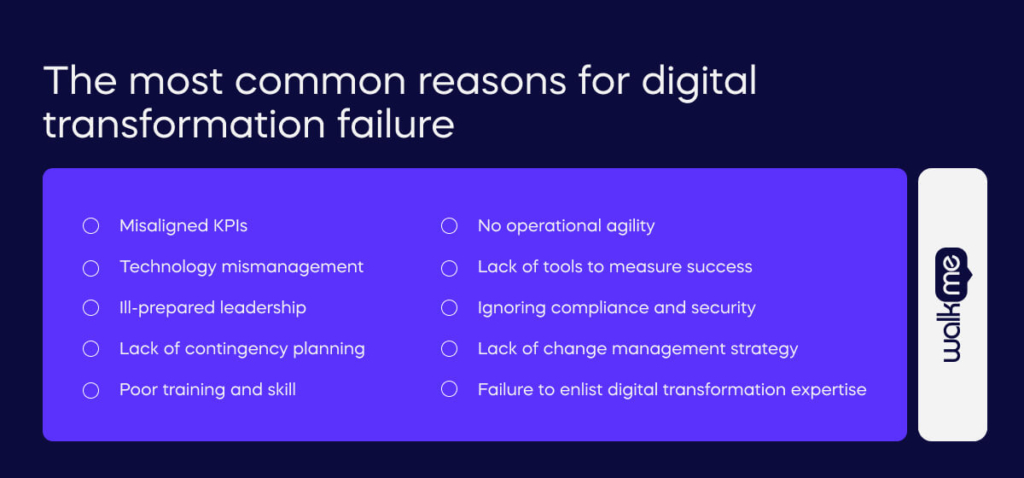You spend millions on a make-or-break transformation but get nothing back in return. What happened?
Perhaps you didn’t thoroughly research the technology or how well it aligned with your KPIs. Maybe you didn’t brief your staff managers on every detail of the digital transformation and how to promote buy-in from the staff to ensure success and quick ROI.
Whatever the reason for failure, fear not. Failing is part of the learning process, and the knowledge gained from it can yield positive outcomes for your next change initiative as you learn how to avoid failure in the future via improved digital adaptation.
This article will delve into the lessons to be learned from high-profile digital transformation failures. It will explore why these transformations often fail, provide examples, discuss common reasons behind digital transformation failures, and examine how a Digital Adoption Platform (DAP) can help mitigate these risks and ensure successful implementation.
Why do most digital transformations fail?
There are ten main reasons why digital transformations fail. Knowing these reasons can help you plan for success by avoiding the reasons other enterprises often fail. The first of these is misaligned KPIs, where the KPIs of the enterprise do not match up with the digital transformation KPIs.
- Misaligned KPIs
- Technology mismanagement
- Ill-prepared leadership
- Lack of contingency planning
- Poor training and skill
- No operational agility
- Lack of tools to measure success
- Ignoring compliance and security
- Lack of change management strategy
- Failure to enlist digital transformation expertise
Be aware of these common reasons for digital transformation failure to avoid failure and work toward success.
6 digital transformation failures examples

The best way to learn how to implement successful technological changes is by examining past digital transformation failures of high-profile enterprises and see what insights we can take from the lessons they learned. The first of these examples is candy manufacturer Haribo.
- Haribo
Imagine candy-maker Haribo’s disappointment when gummy bears became largely unavailable in 2018 due to the implementation of a tumultuous SAP (systems applications and products in data processing).
Haribo invested hundreds of millions in SAP implementation in a bid for modernization. While the system went live, the sweetness quickly curdled into chaos. Supply chain snarls erupted, leaving Haribo blind to inventory location, raw material tracking, and timely deliveries.
The consequences were harsh, with 25% of sales plummeting shortly after the transformation.
This example highlights the potential pitfalls of even the most well-intentioned digital transformations. It serves as a poignant reminder that even established brands like Haribo are not immune to the challenges of complex system integrations.
Lessons
- Set realistic goals: Ambitious goals are great, but ensure your implementation plan is practical and phased. Remember, complex systems like SAP require meticulous planning and gradual adoption over years, not months.
- Prioritize data integrity before implementation: Before going live, make sure data from old and new systems is accurate and reconciled. Like Haribo’s, untracked inventory and raw materials can cause significant disruptions and hamper your success.
- Offer training (and retraining): Implementing new software isn’t just about flipping a switch; it’s about changing habits. Invest in thorough training and ongoing support for users to fully leverage the system’s potential and avoid supply chain snarls.
Haribo’s experience reminds us that even seemingly perfect plans can get sticky. By prioritizing realistic goals, clean data, and user adoption, your digital transformation can be smooth, not a bumpy road paved with missing gummy bears.
- Nike
Nike, the athletic apparel giant, embarked on a seemingly grand quest to upgrade its ERP systems. Armed with a USD 400 million budget, their ambitions soared high. Spoiler alert: they landed face-first.
The fallout was dramatic. A USD 100 million loss, a 20% stock price plunge, another five years, and USD 400 million ended up in the actions to try to fix the project. While rumors suggest Nike finally found its footing, the question lingers: was this rocky USD 800 million odyssey necessary?
Lessons
- Focus on relevant goals: Don’t overshoot with extravagant goals, neglect a practical, phased approach, and avoid tailoring your system to your needs only for a costly but superficial trophy of technological prowess.
- Optimize your processes: Overhauls without purpose cripple progress. Prioritize lean efficiency, not bloated complexity, make data-driven decisions, and embrace agility. Build adaptable processes that bend, not break, with each digital wave.
- Implement correctly: Align goals, resources, and timelines for a smooth voyage. Communication is key because transparency fuels trust. Keep stakeholders informed and engaged throughout the journey and celebrate milestones, as progress deserves recognition.
Nike’s story serves as a reminder that even the mightiest can stumble on the path of digital transformation. While the ending may be happy, the scars remain, whispering a crucial message: prioritize a practical approach, optimize before you digitize, and remember, technology is merely a tool—its true power lies in how we support our staff to use it.
- United States Navy
A 2005 report by the Government Accountability Office (GAO) sheds light on a potentially cautionary but instructive case study in large-scale IT project implementation within the US Department of Defense.
This particular branch, unnamed in the report, embarked on an Enterprise Resource Planning (ERP) project with ambitious goals – goals that, unfortunately, remain mainly unfulfilled to this day.
Despite exceeding USD 1 billion in expenditures and enlisting the support of three major system integrators (IBM, Lloyd, and EDS), the project has yet to deliver tangible improvements to the organization.
Notably, the project’s scope has been significantly reduced, excluding crucial areas like shipyard inventory management and focusing solely on the financial segment. This strategic narrowing failed to mitigate the challenges, highlighting potential project management and system fit issues.
While the specifics of this project remain confidential, the GAO’s report offers valuable lessons for any organization contemplating a significant IT transformation initiative. Key takeaways include:
Lessons
- Clearly defined goals and realistic expectations: A comprehensive understanding of desired outcomes and their alignment with system capabilities is paramount.
- Thorough vendor selection and project management: Partnering with experienced and compatible vendors and strong project leadership is crucial for success.
- Continuous evaluation and course correction: Regular assessments of progress and adaptation to evolving needs are vital to prevent project derailment.
- User focus and practical training: Prioritizing user adoption and ensuring adequate training are essential for maximizing system value.
The US military branch’s ERP saga may not have a happy ending yet, but it serves as a valuable reminder of the pitfalls lurking within seemingly transformative projects. By analyzing this case, organizations can learn from these experiences, mitigate risks, and navigate their IT journeys with greater clarity and caution.
- Washington Community College
Washington Community College entrusted Ciber, a seemingly capable system integrator, to guide their PeopleSoft implementation in 2012. However, just as the project gained momentum, disaster struck. Cyber filed for bankruptcy, vanishing like a mirage in the digital desert.
The college, its PeopleSoft ambitions half-baked, was left stranded with an incomplete system and a mounting pile of unfulfilled promises.
Enter HDC, a company that acquired Ciber’s remnants. Hope flickered momentarily as HDC picked up the pieces and attempted to resurrect the project. But, after considerable effort, HDC made a critical decision: it pulled the plug. This time, the termination wasn’t the college’s doing but a calculated withdrawal by the vendor.
HDC didn’t leave quietly. Instead, it turned the tables and filed a USD 13 million lawsuit against the college. The claim? Internal dysfunctions within the college allegedly hampered the project, rendering it unviable. This unprecedented twist painted a picture of shared responsibility, with both parties playing roles in the project’s demise.
Washington Community College’s ordeal is a chilling cautionary tale for any organization contemplating an ERP implementation. The consequences of poorly chosen partners and unforeseen circumstances can be crippling, leaving institutions adrift in a sea of wasted resources and unfulfilled goals. Here are some key takeaways:
Lessons
- Vet potential vendors meticulously: Thorough due diligence is crucial to avoid relying on shaky foundations. Research financial stability, track record, and client satisfaction before handing over the reins.
- Prepare for the unexpected: Develop contingency plans to navigate potential disruptions and setbacks. A flexible approach can mitigate the impact of unforeseen circumstances.
- Communication is key: Maintain open and transparent communication with vendors throughout the process. Early problem identification and collaborative solutions can prevent issues from festering.
- Nokia
Nokia’s USD 7.2 billion deal in September 2013 to offload its handset business to Microsoft paints a bittersweet picture.
Nokia wasn’t a rigid behemoth. It pivoted with surprising agility throughout its history, shedding businesses like paper mills and galoshes to focus on mobile phone design and manufacture. It even streamlined its conglomerate structure in the 90s, focusing solely on telecom.
Technology wasn’t a hurdle either. Nokia boasted a 1996 smartphone prototype and a visionary touch-screen design in the late 90s. R&D was a top priority, with hefty investments thrown at innovation.
The crux of the issue was converting brilliance into consumer desire. Nokia was a hardware powerhouse at its core – its engineers mastered the physical phone, but the software soul remained elusive.
Apps, user experience, and the software ecosystem – all areas Apple prioritized – were tragically underestimated. Nokia’s development process, dominated by hardware engineers, kept software experts on the periphery.
In stark contrast, Apple saw hardware and software as two sides of the same coin. Multidisciplinary teams designed holistic experiences, not just sleek devices.
Lessons
- Software is king: Prioritizing hardware engineering over software understanding can be fatal in a software-driven world. Focus on seamless user experience, intuitive interfaces, and a robust app ecosystem, not just cutting-edge tech specs.
- Embrace cross-functionality: Break down silos! Software and hardware need to work in tandem. Foster collaboration between engineers, designers, and marketers to create holistic digital experiences that meet user needs and desires.
- Agility trumps tradition: Adaptability is key. Don’t let established processes or internal hierarchies hinder your ability to pivot and evolve with changing market trends and user preferences.
Nokia’s story is a story for hardware giants caught in the software age. It’s not enough to build exceptional tech; understanding the user, embracing the software symphony, and building intuitive experiences are the keys to winning hearts and conquering markets.
- Co-Op Bank
The Co-operative Bank’s ill-fated digital transformation remains a warning in the annals of IT mishaps. Embarking on a USD 3.8 million overhaul of its infrastructure in 2006, the bank dreamt of becoming the first UK bank to replace its core banking systems fully. Yet, this ambitious dream turned into a USD 1.9 billion nightmare.
Replacing core banking systems is akin to open-heart surgery on a running computer. The Co-op underestimated the sheer complexity of such a radical overhaul, leading to cascading issues within the project.
Prominent IT leaders leaving mid-transformation and a lack of full engagement from senior staff created a void in direction and expertise. This critical gap significantly hampered the project’s ability to navigate through challenges.
Underdeveloped plans constantly revised on the fly proved disastrous. Without a clear roadmap and consistent adherence, the project lacked stability and became vulnerable to scope creep and budget overruns.
Lessons
- Achievable ambitions: Bolder isn’t always better. Assessing project complexity and capacity is crucial before embarking on ambitious tech overhauls.
- Leadership consistency: Strong, consistent leadership from the start is essential to navigate the inevitable hurdles and keep the project focused on its goals.
- Agile, stable roadmap: Flexibility is critical, but not at the expense of a clear roadmap. Robust, well-defined plans with room for adaptation can guide the project through unforeseen challenges.
What are the most common reasons for digital transformation failure?

There are many reasons for digital transformation failure. Despite the reasons feeling like they only apply to your organization, the reasons occur in patterns, making them easier to understand and avoid. Misaligned KPIs are among the most common, as organizations tend not to ensure overarching KPIs align with their digital transformation.
Check out these reasons for transformation failure below to understand and avoid them.
Misaligned KPIs
Misaligned KPIs act as sirens, luring organizations down paths of vanity metrics and hollow achievements. Chasing website visits instead of conversions is like filling a leaky bucket – activity masquerades as progress while actual value slips through the cracks.
To succeed, businesses must rigorously scrutinize KPIs, ensuring they illuminate, not block, the path toward genuine, lasting digital transformation.
Technology mismanagement
Ill-fitting tech choices and integration nightmares stitch together a Frankenstein’s monster of digital dysfunction. Clunky workflows and isolated data silos suffocate progress, turning a promised land of efficiency into a wasteland of wasted resources.
This tech burden drags down even the most agile organization, reminding us that digital transformation demands clear vision and intelligent execution.
Ill-prepared leadership
Employee motivation wanes amidst the doldrums of inaction, their morale sinking under uninspired guidance. Organizations need leaders with unclouded vision and a solid resolve to unlock the full potential of transformation.
These bold captains, evident in their goals and persistent in their pursuit, can rally their teams and navigate the uncharted waters of change, steering them toward the shores of success.
Lack of contingency planning
Unforeseen roadblocks are inevitable in the dynamic landscape of digital transformation. Imagine embarking on a pioneering expedition without a trusty map and compass – a single storm can send an unprepared team spiraling off course. The key lies in agility, not rigidity.
Remember, the winds of change may negatively impact your journey, but a flexible mindset can transform them from perilous gales into propelling forces, guiding you toward success.
Poor training and skill
Investing in upskilling and training equips your crew with the latest navigational equipment expertise. This expertise ensures the team confidently charts a course towards the digital harbor, not towards uncharted reefs of obsolescence. Remember, your transformation voyage is only as successful as the skills propelling it forward.
No operational agility
Rigidity casts a leaden anchor on the ship of digital progress. Inflexible processes and static workflows become roadblocks, snarling the journey in bureaucratic delays. Organizations must embrace the winds of continuous improvement and iterate with rapidity to navigate these treacherous waters.
Businesses can reach the digital transformation they need to remain sustainable by shedding the shackles of rigidity and charting a course of agile adaptation.
Lack of tools to measure success
Robust metrics and insightful monitoring systems become your essential navigational lights, illuminating progress, revealing hidden currents of inefficiency, and allowing for timely course corrections before treacherous challenges loom. Businesses can confidently steer toward success by illuminating the path with quantifiable data.
Ignoring compliance and security
Prioritizing robust security measures and stringent compliance safeguards becomes your essential life preserver, protecting your organization from lurking cyber-krakens and unexpected regulatory squalls. By fortifying your digital vessel with watertight defenses, you ensure a smooth sail toward the secure shores of digital prosperity, ready to weather any storm.
Lack of change management strategy
Neglecting a comprehensive change management strategy is akin to throwing your team into churning seas without lifeboats – disoriented, resistant, and prone to capsizing the entire transformation journey.
By investing in clear communication, training, and support, you ensure your crew remains on board and actively steering toward the digital harbor, united and empowered to navigate the uncharted waters ahead.
Failure to enlist digital transformation expertise
Venturing into the uncharted lands of digital transformation without experienced guides is like trying to navigate a desert with a compass needle held together by duct tape. Sure, you might manage to make some headway, but the chances of getting hopelessly lost or hitting treacherous sandstorms are alarmingly high.
How can a DAP prevent digital transformation failures?
The specter of failure looms large over digital transformations, with staggering percentages falling short of their ambitious goals. Yet, amidst the wreckage, a beacon of hope emerges from the digital adoption platform (DAP).
Imagine a world where employees seamlessly embrace new technology, empowered by intuitive guidance and contextual support. DAPs make this a reality.
They act as digital guides, providing step-by-step guidance, interactive walkthroughs, and real-time feedback woven directly into the new systems. This scenario fosters user confidence, reduces anxiety, and accelerates learning, propelling teams to proficiency as they learn digital transformation skills.
But DAPs go beyond mere training. They gather valuable user data, identifying adoption roadblocks and pain points before they morph into insurmountable obstacles and streamlining digital employee onboarding during a transformation. The learning feature allows swift course correction, tailoring the implementation strategy to address specific user needs and preferences.
DAPs rewrite the digital transformation narrative by investing in user experience and closing the adoption gap. They transform once-fraught journeys into expeditions fueled by confident, empowered users, paving the way for a future where technology truly transforms, not disrupts, the way we work.
Incorporate failure to secure success
In the face of failure, it’s tempting to retreat and cling to what’s familiar. But within these failures are valuable lessons, blueprints for success forged through adversity.
Navigate digital transformation with clarity and determination by examining these failures, acknowledging uncomfortable truths, and integrating insights into strategies.
Rather than seeing failure as a setback, view it as a stepping stone toward a future where technology drives organizational excellence.
Embrace the potential for growth in failure, using it as fuel for future success. This approach fosters a forward-thinking atmosphere and encourages staff to confront digital transformation challenges with understanding and purpose, ensuring sustained success and morale.


